Business Law Assignment: Cases on Contract Law and Torts
VerifiedAdded on 2021/04/24
|6
|1029
|76
Homework Assignment
AI Summary
This business law assignment solution addresses four key issues through legal analysis and case studies. The first issue examines negligent misrepresentation, with a focus on Emma's liability for providing incorrect information to Richard, referencing the Hedley Byrne & Co Ltd v Heller & Partners Ltd case. The second issue explores promissory estoppel, analyzing whether George can claim additional rent from Richard, citing the Central London Property Trust Ltd v High Trees Ltd and Tool Metal Manufacturing v Tungsten cases. The third issue concerns contract law and counteroffers, determining if Richard can enforce Tom to sell his car based on the original offer, referencing the Hyde v Wrench case. Finally, the fourth issue evaluates the existence of a contract between Martin and Richard, focusing on past consideration and referencing the Eastwood v Kenyon and Re McArdle cases. The assignment concludes with a bibliography of relevant legal resources.
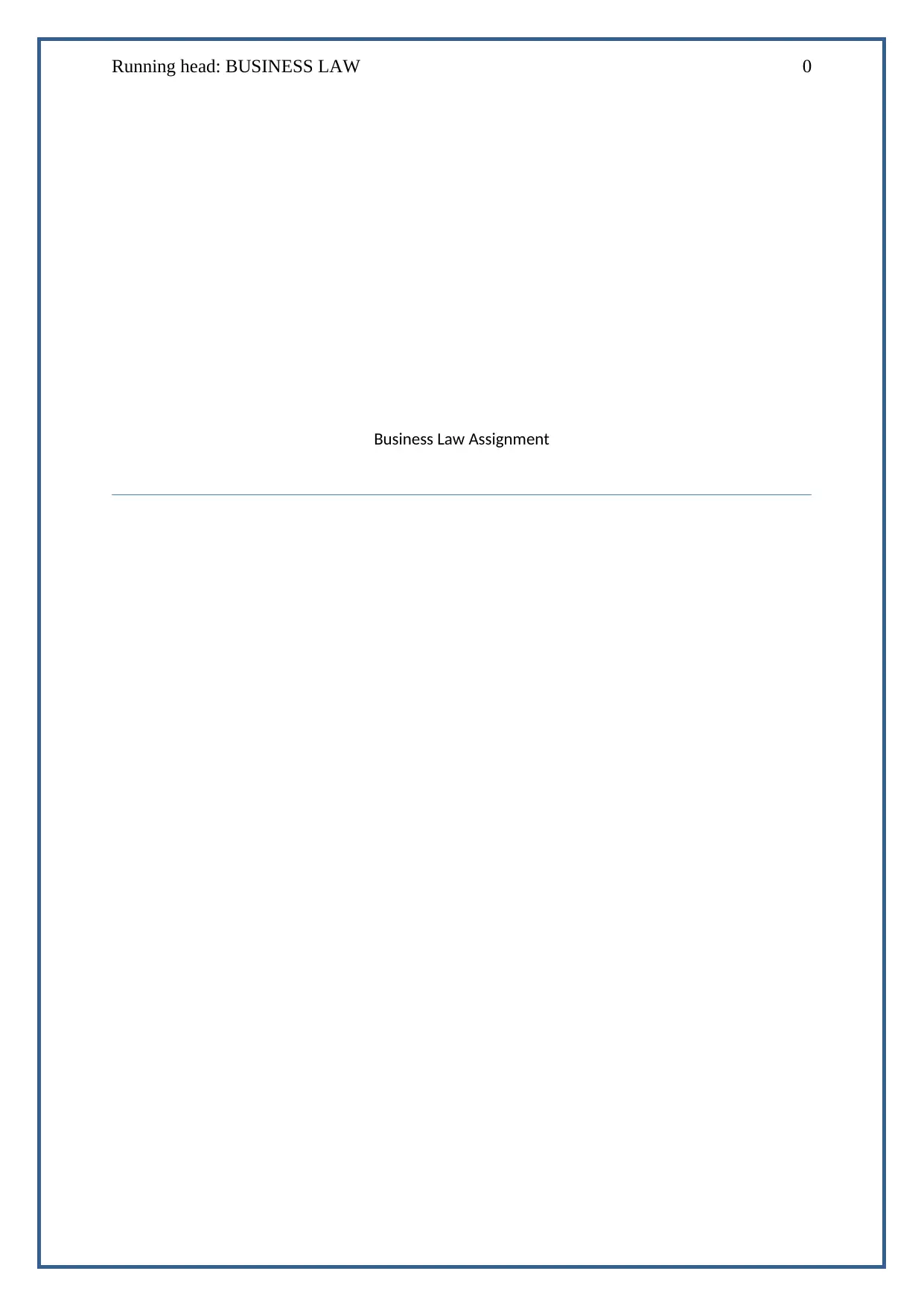
Running head: BUSINESS LAW 0
Business Law Assignment
Business Law Assignment
Paraphrase This Document
Need a fresh take? Get an instant paraphrase of this document with our AI Paraphraser
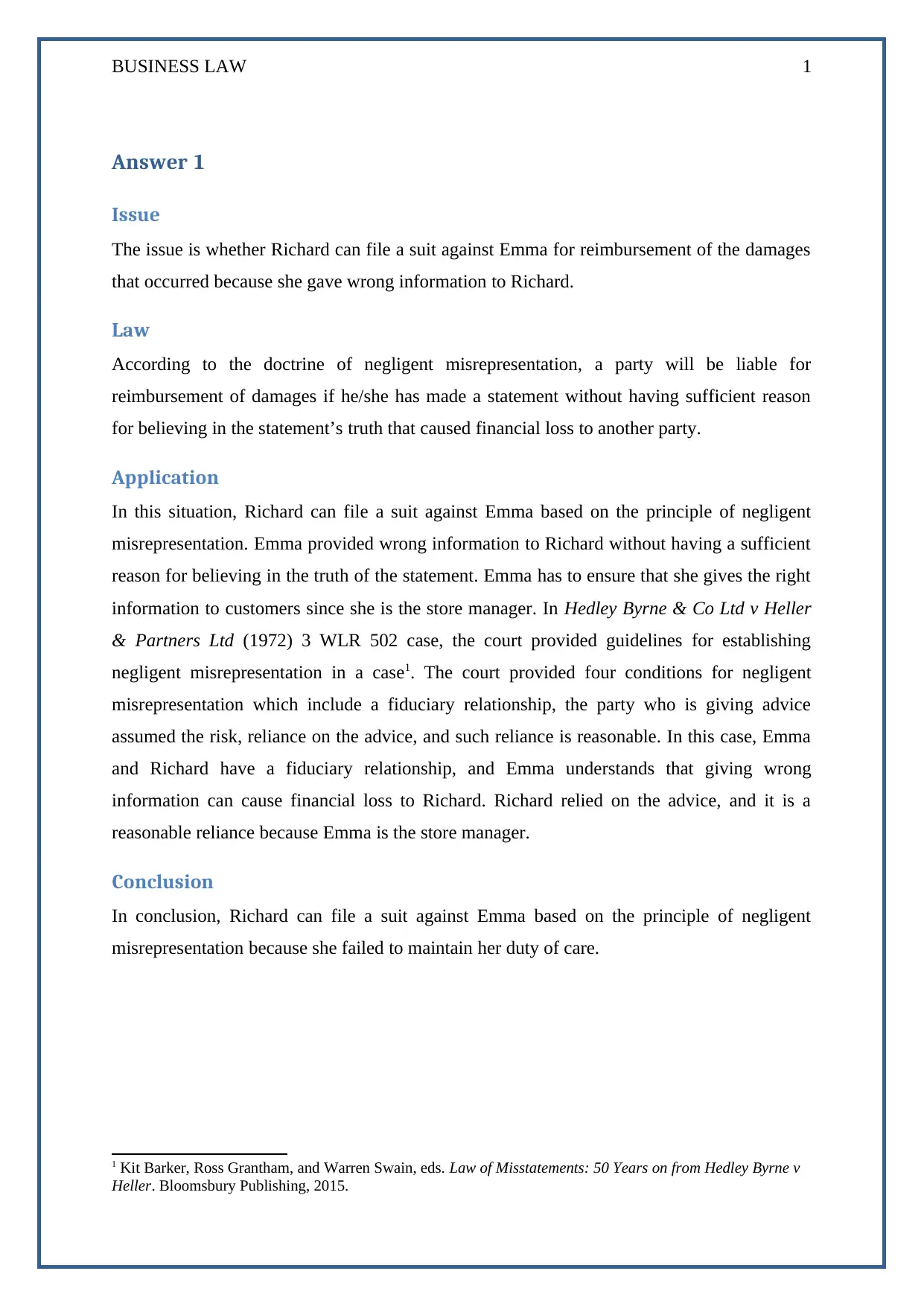
BUSINESS LAW 1
Answer 1
Issue
The issue is whether Richard can file a suit against Emma for reimbursement of the damages
that occurred because she gave wrong information to Richard.
Law
According to the doctrine of negligent misrepresentation, a party will be liable for
reimbursement of damages if he/she has made a statement without having sufficient reason
for believing in the statement’s truth that caused financial loss to another party.
Application
In this situation, Richard can file a suit against Emma based on the principle of negligent
misrepresentation. Emma provided wrong information to Richard without having a sufficient
reason for believing in the truth of the statement. Emma has to ensure that she gives the right
information to customers since she is the store manager. In Hedley Byrne & Co Ltd v Heller
& Partners Ltd (1972) 3 WLR 502 case, the court provided guidelines for establishing
negligent misrepresentation in a case1. The court provided four conditions for negligent
misrepresentation which include a fiduciary relationship, the party who is giving advice
assumed the risk, reliance on the advice, and such reliance is reasonable. In this case, Emma
and Richard have a fiduciary relationship, and Emma understands that giving wrong
information can cause financial loss to Richard. Richard relied on the advice, and it is a
reasonable reliance because Emma is the store manager.
Conclusion
In conclusion, Richard can file a suit against Emma based on the principle of negligent
misrepresentation because she failed to maintain her duty of care.
1 Kit Barker, Ross Grantham, and Warren Swain, eds. Law of Misstatements: 50 Years on from Hedley Byrne v
Heller. Bloomsbury Publishing, 2015.
Answer 1
Issue
The issue is whether Richard can file a suit against Emma for reimbursement of the damages
that occurred because she gave wrong information to Richard.
Law
According to the doctrine of negligent misrepresentation, a party will be liable for
reimbursement of damages if he/she has made a statement without having sufficient reason
for believing in the statement’s truth that caused financial loss to another party.
Application
In this situation, Richard can file a suit against Emma based on the principle of negligent
misrepresentation. Emma provided wrong information to Richard without having a sufficient
reason for believing in the truth of the statement. Emma has to ensure that she gives the right
information to customers since she is the store manager. In Hedley Byrne & Co Ltd v Heller
& Partners Ltd (1972) 3 WLR 502 case, the court provided guidelines for establishing
negligent misrepresentation in a case1. The court provided four conditions for negligent
misrepresentation which include a fiduciary relationship, the party who is giving advice
assumed the risk, reliance on the advice, and such reliance is reasonable. In this case, Emma
and Richard have a fiduciary relationship, and Emma understands that giving wrong
information can cause financial loss to Richard. Richard relied on the advice, and it is a
reasonable reliance because Emma is the store manager.
Conclusion
In conclusion, Richard can file a suit against Emma based on the principle of negligent
misrepresentation because she failed to maintain her duty of care.
1 Kit Barker, Ross Grantham, and Warren Swain, eds. Law of Misstatements: 50 Years on from Hedley Byrne v
Heller. Bloomsbury Publishing, 2015.
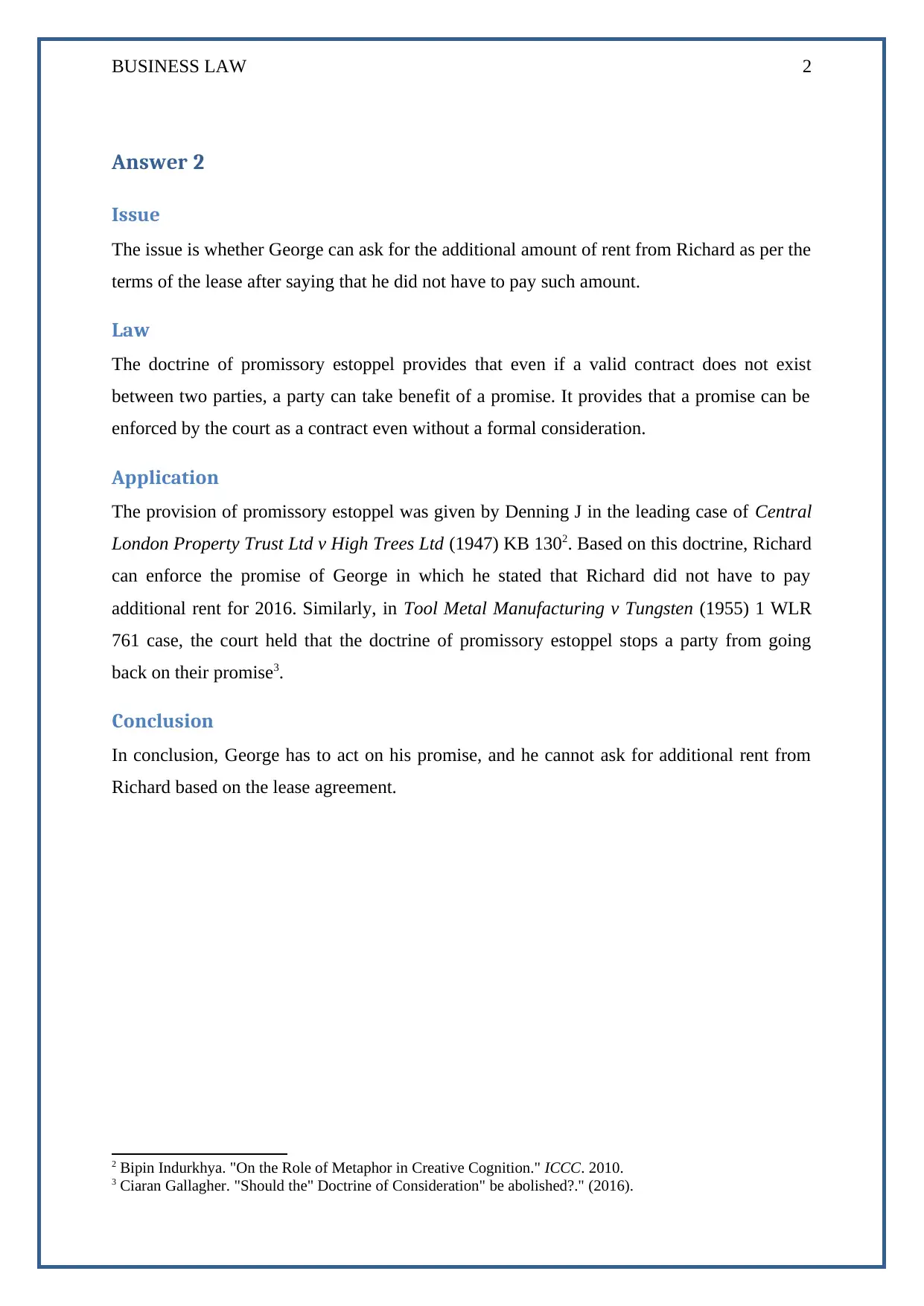
BUSINESS LAW 2
Answer 2
Issue
The issue is whether George can ask for the additional amount of rent from Richard as per the
terms of the lease after saying that he did not have to pay such amount.
Law
The doctrine of promissory estoppel provides that even if a valid contract does not exist
between two parties, a party can take benefit of a promise. It provides that a promise can be
enforced by the court as a contract even without a formal consideration.
Application
The provision of promissory estoppel was given by Denning J in the leading case of Central
London Property Trust Ltd v High Trees Ltd (1947) KB 1302. Based on this doctrine, Richard
can enforce the promise of George in which he stated that Richard did not have to pay
additional rent for 2016. Similarly, in Tool Metal Manufacturing v Tungsten (1955) 1 WLR
761 case, the court held that the doctrine of promissory estoppel stops a party from going
back on their promise3.
Conclusion
In conclusion, George has to act on his promise, and he cannot ask for additional rent from
Richard based on the lease agreement.
2 Bipin Indurkhya. "On the Role of Metaphor in Creative Cognition." ICCC. 2010.
3 Ciaran Gallagher. "Should the" Doctrine of Consideration" be abolished?." (2016).
Answer 2
Issue
The issue is whether George can ask for the additional amount of rent from Richard as per the
terms of the lease after saying that he did not have to pay such amount.
Law
The doctrine of promissory estoppel provides that even if a valid contract does not exist
between two parties, a party can take benefit of a promise. It provides that a promise can be
enforced by the court as a contract even without a formal consideration.
Application
The provision of promissory estoppel was given by Denning J in the leading case of Central
London Property Trust Ltd v High Trees Ltd (1947) KB 1302. Based on this doctrine, Richard
can enforce the promise of George in which he stated that Richard did not have to pay
additional rent for 2016. Similarly, in Tool Metal Manufacturing v Tungsten (1955) 1 WLR
761 case, the court held that the doctrine of promissory estoppel stops a party from going
back on their promise3.
Conclusion
In conclusion, George has to act on his promise, and he cannot ask for additional rent from
Richard based on the lease agreement.
2 Bipin Indurkhya. "On the Role of Metaphor in Creative Cognition." ICCC. 2010.
3 Ciaran Gallagher. "Should the" Doctrine of Consideration" be abolished?." (2016).
⊘ This is a preview!⊘
Do you want full access?
Subscribe today to unlock all pages.

Trusted by 1+ million students worldwide
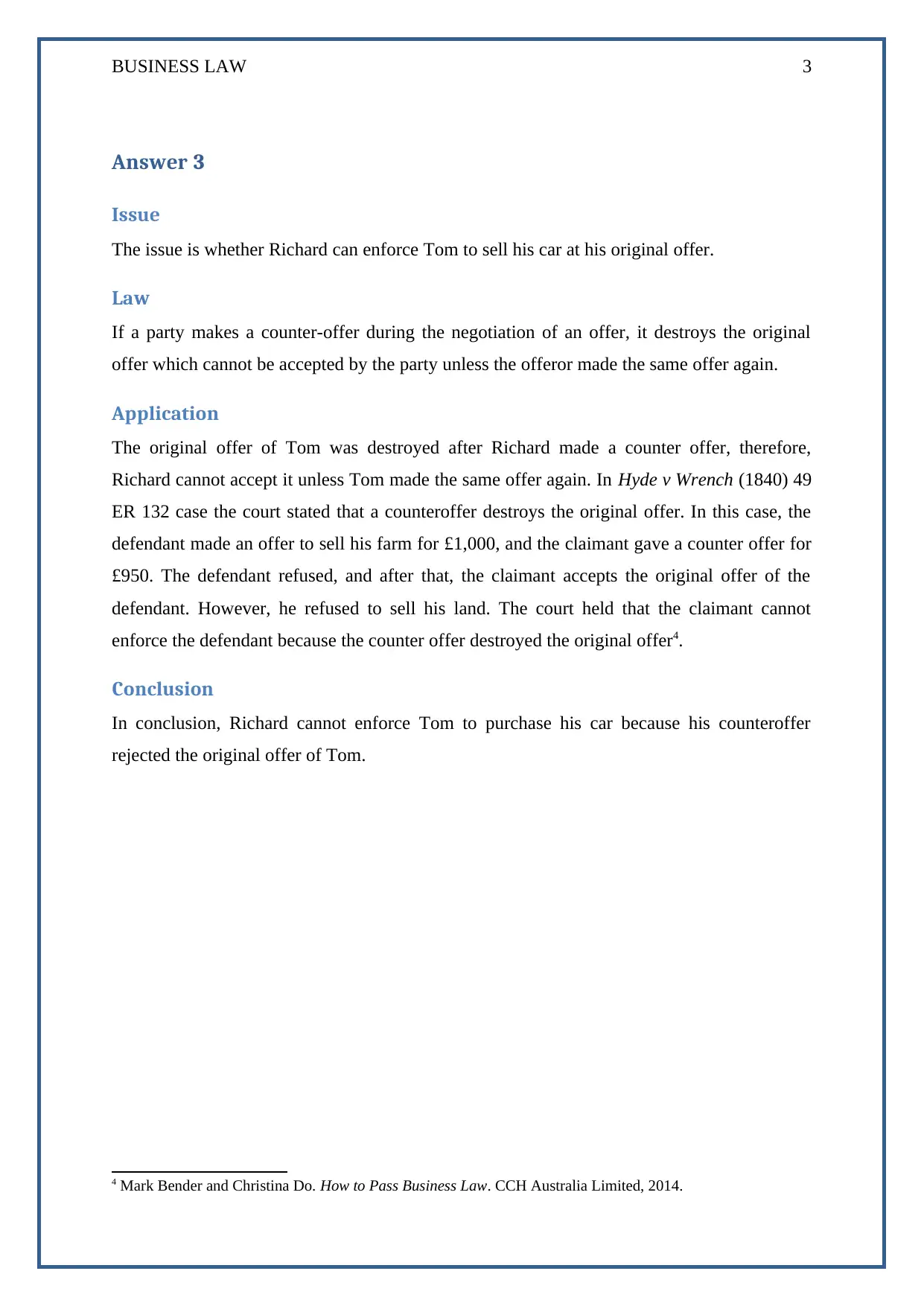
BUSINESS LAW 3
Answer 3
Issue
The issue is whether Richard can enforce Tom to sell his car at his original offer.
Law
If a party makes a counter-offer during the negotiation of an offer, it destroys the original
offer which cannot be accepted by the party unless the offeror made the same offer again.
Application
The original offer of Tom was destroyed after Richard made a counter offer, therefore,
Richard cannot accept it unless Tom made the same offer again. In Hyde v Wrench (1840) 49
ER 132 case the court stated that a counteroffer destroys the original offer. In this case, the
defendant made an offer to sell his farm for £1,000, and the claimant gave a counter offer for
£950. The defendant refused, and after that, the claimant accepts the original offer of the
defendant. However, he refused to sell his land. The court held that the claimant cannot
enforce the defendant because the counter offer destroyed the original offer4.
Conclusion
In conclusion, Richard cannot enforce Tom to purchase his car because his counteroffer
rejected the original offer of Tom.
4 Mark Bender and Christina Do. How to Pass Business Law. CCH Australia Limited, 2014.
Answer 3
Issue
The issue is whether Richard can enforce Tom to sell his car at his original offer.
Law
If a party makes a counter-offer during the negotiation of an offer, it destroys the original
offer which cannot be accepted by the party unless the offeror made the same offer again.
Application
The original offer of Tom was destroyed after Richard made a counter offer, therefore,
Richard cannot accept it unless Tom made the same offer again. In Hyde v Wrench (1840) 49
ER 132 case the court stated that a counteroffer destroys the original offer. In this case, the
defendant made an offer to sell his farm for £1,000, and the claimant gave a counter offer for
£950. The defendant refused, and after that, the claimant accepts the original offer of the
defendant. However, he refused to sell his land. The court held that the claimant cannot
enforce the defendant because the counter offer destroyed the original offer4.
Conclusion
In conclusion, Richard cannot enforce Tom to purchase his car because his counteroffer
rejected the original offer of Tom.
4 Mark Bender and Christina Do. How to Pass Business Law. CCH Australia Limited, 2014.
Paraphrase This Document
Need a fresh take? Get an instant paraphrase of this document with our AI Paraphraser
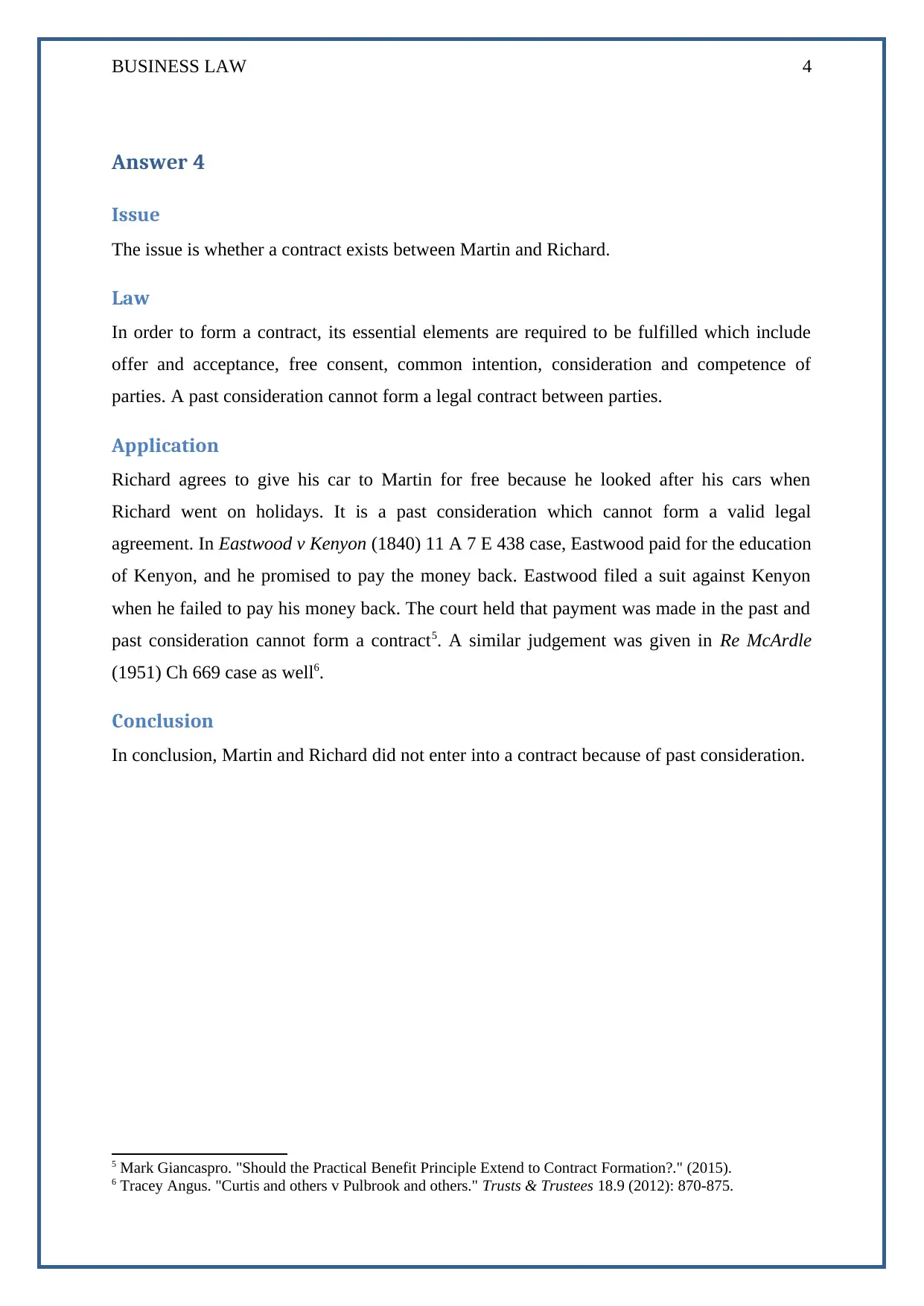
BUSINESS LAW 4
Answer 4
Issue
The issue is whether a contract exists between Martin and Richard.
Law
In order to form a contract, its essential elements are required to be fulfilled which include
offer and acceptance, free consent, common intention, consideration and competence of
parties. A past consideration cannot form a legal contract between parties.
Application
Richard agrees to give his car to Martin for free because he looked after his cars when
Richard went on holidays. It is a past consideration which cannot form a valid legal
agreement. In Eastwood v Kenyon (1840) 11 A 7 E 438 case, Eastwood paid for the education
of Kenyon, and he promised to pay the money back. Eastwood filed a suit against Kenyon
when he failed to pay his money back. The court held that payment was made in the past and
past consideration cannot form a contract5. A similar judgement was given in Re McArdle
(1951) Ch 669 case as well6.
Conclusion
In conclusion, Martin and Richard did not enter into a contract because of past consideration.
5 Mark Giancaspro. "Should the Practical Benefit Principle Extend to Contract Formation?." (2015).
6 Tracey Angus. "Curtis and others v Pulbrook and others." Trusts & Trustees 18.9 (2012): 870-875.
Answer 4
Issue
The issue is whether a contract exists between Martin and Richard.
Law
In order to form a contract, its essential elements are required to be fulfilled which include
offer and acceptance, free consent, common intention, consideration and competence of
parties. A past consideration cannot form a legal contract between parties.
Application
Richard agrees to give his car to Martin for free because he looked after his cars when
Richard went on holidays. It is a past consideration which cannot form a valid legal
agreement. In Eastwood v Kenyon (1840) 11 A 7 E 438 case, Eastwood paid for the education
of Kenyon, and he promised to pay the money back. Eastwood filed a suit against Kenyon
when he failed to pay his money back. The court held that payment was made in the past and
past consideration cannot form a contract5. A similar judgement was given in Re McArdle
(1951) Ch 669 case as well6.
Conclusion
In conclusion, Martin and Richard did not enter into a contract because of past consideration.
5 Mark Giancaspro. "Should the Practical Benefit Principle Extend to Contract Formation?." (2015).
6 Tracey Angus. "Curtis and others v Pulbrook and others." Trusts & Trustees 18.9 (2012): 870-875.
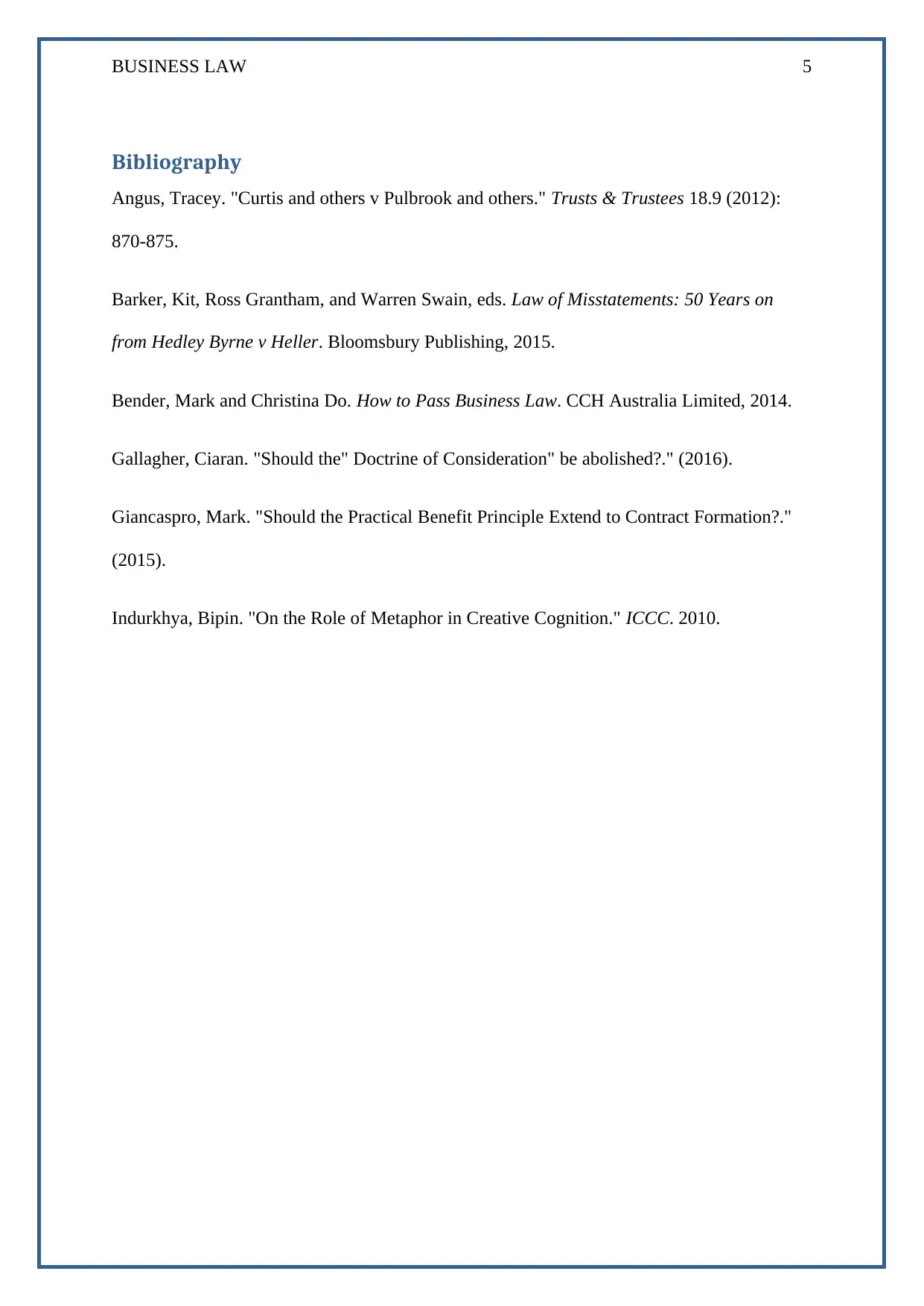
BUSINESS LAW 5
Bibliography
Angus, Tracey. "Curtis and others v Pulbrook and others." Trusts & Trustees 18.9 (2012):
870-875.
Barker, Kit, Ross Grantham, and Warren Swain, eds. Law of Misstatements: 50 Years on
from Hedley Byrne v Heller. Bloomsbury Publishing, 2015.
Bender, Mark and Christina Do. How to Pass Business Law. CCH Australia Limited, 2014.
Gallagher, Ciaran. "Should the" Doctrine of Consideration" be abolished?." (2016).
Giancaspro, Mark. "Should the Practical Benefit Principle Extend to Contract Formation?."
(2015).
Indurkhya, Bipin. "On the Role of Metaphor in Creative Cognition." ICCC. 2010.
Bibliography
Angus, Tracey. "Curtis and others v Pulbrook and others." Trusts & Trustees 18.9 (2012):
870-875.
Barker, Kit, Ross Grantham, and Warren Swain, eds. Law of Misstatements: 50 Years on
from Hedley Byrne v Heller. Bloomsbury Publishing, 2015.
Bender, Mark and Christina Do. How to Pass Business Law. CCH Australia Limited, 2014.
Gallagher, Ciaran. "Should the" Doctrine of Consideration" be abolished?." (2016).
Giancaspro, Mark. "Should the Practical Benefit Principle Extend to Contract Formation?."
(2015).
Indurkhya, Bipin. "On the Role of Metaphor in Creative Cognition." ICCC. 2010.
⊘ This is a preview!⊘
Do you want full access?
Subscribe today to unlock all pages.

Trusted by 1+ million students worldwide
1 out of 6
Related Documents
Your All-in-One AI-Powered Toolkit for Academic Success.
+13062052269
info@desklib.com
Available 24*7 on WhatsApp / Email
![[object Object]](/_next/static/media/star-bottom.7253800d.svg)
Unlock your academic potential
Copyright © 2020–2025 A2Z Services. All Rights Reserved. Developed and managed by ZUCOL.





